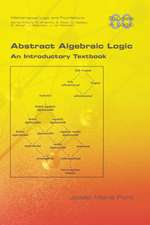Algorithmic and Geometric Aspects of Robotics (Routledge Revivals)
Editat de Jacob T. Schwartz, Chee-Keng Yapen Limba Engleză Hardback – 7 iun 2016
| Toate formatele și edițiile | Preț | Express |
|---|---|---|
| Paperback (1) | 308.13 lei 6-8 săpt. | |
| CRC Press – 31 mar 2021 | 308.13 lei 6-8 săpt. | |
| Hardback (1) | 782.55 lei 6-8 săpt. | |
| CRC Press – 7 iun 2016 | 782.55 lei 6-8 săpt. |
Preț: 782.55 lei
Preț vechi: 1181.19 lei
-34% Nou
Puncte Express: 1174
Preț estimativ în valută:
149.79€ • 162.76$ • 125.90£
149.79€ • 162.76$ • 125.90£
Carte tipărită la comandă
Livrare economică 21 aprilie-05 mai
Preluare comenzi: 021 569.72.76
Specificații
ISBN-13: 9781138203471
ISBN-10: 1138203475
Pagini: 322
Dimensiuni: 156 x 234 mm
Greutate: 0.45 kg
Ediția:1
Editura: CRC Press
Colecția Routledge
ISBN-10: 1138203475
Pagini: 322
Dimensiuni: 156 x 234 mm
Greutate: 0.45 kg
Ediția:1
Editura: CRC Press
Colecția Routledge
Public țintă
Postgraduate and UndergraduateCuprins
Preface; Introduction Chee-Keng Yap; 1. Why Robotics? 2. An Overview of the Contents of the Volume 3. Brief Review of Standard Terminology; 1. The Challenge of Robotics for computer Science John E. Hopcroft and Dean B. Krafft; 1. What is Robotics? 2. A New Science 3. Representations for Physical Objects and processes 4. Manipulating Object Representations 5. Reasoning 6. Conclusions References; 2. Computational Geometry — A User’s Guide David P. Dobkin and Diane L. Souvaine; 1. Introduction 2. Hierarchical Search 3. Hierarchical Computation 4. Geometric Transformations 5. Conclusion References; 3. Algorithmic Motion Planning Chee-Keng Yap; 1. History 2. Basic Concepts 3. A Taxonomy of Motion Planning Problems 4. Issues related to Algorithmic Motion Planning 5. Moving a Disc 6. Moving a Ladder 7. Two Approaches to Motion Planning 8. Solution to the General Motion Planning Problem 9. Retraction Via Cell Complexes 10. Lower Bounds 11. Summary: New Directions and Open Problems 12. Conclusion References; 4. Approximation and Decomposition of Shapes Bernard Chazelle; 1. Introduction 2. Approximation of Shapes 3. Decomposition of Shapes 4. Epilogue References; 5. Intersection and Proximity Problems and Voronoi Diagrams Daniel Leven and Micha Sharir; 1. Introduction 2. A Simple Intersection Detection Algorithm in Two-Dimensional Space 3. Generalized Planar Voronoi Diagrams 4. Applications of Voronoi Diagrams 5. Efficient Construction of Voronoi Diagrams 6. Dynamic Intersection and Proximity Problems 7. The Three-Dimensional Case References; 6. Fleshing Out Wire Frames: Reconstruction of Objects, Part I George Markowsky and Michael A. Wesley; 1. Introduction 2. Basic concepts 3. The Wire Frame Algorithm 4. Examples Appendix A: Topological Concepts References; 7. Fleshing Out Projections: Reconstruction of Objects, Part II Michael A. Wesley and George Markowsky; 1. Introduction 2. Basic Concepts and Results 3. Fleshing Out Unlabled Projections 4. Additional Information from Drawing Conventions 5. Examples 6. Summary References; Author Index; Subject Index
Notă biografică
Jacob T. Schwartz, Chee-Keng Yap
Descriere
First published in 1987, the seven chapters that comprise this book review contemporary work on the geometric side of robotics.





























